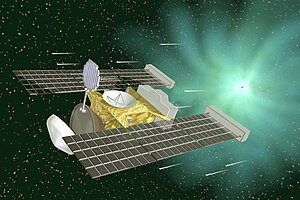 Artist's impression of Stardust collecting dust particles from Comet Wild 2 | |||||||||||||
| Names | Discovery 4 Stardust-NExT | ||||||||||||
|---|---|---|---|---|---|---|---|---|---|---|---|---|---|
| Mission type | Sample return | ||||||||||||
| Operator | NASA / JPL | ||||||||||||
| COSPAR ID | 1999-003A | ||||||||||||
| SATCAT no. | 25618 | ||||||||||||
| Website | solarsystem.nasa.gov | ||||||||||||
| Mission duration | Stardust: 6 years, 11 months, 8 days NExT: 4 years, 2 months, 7 days Total: 12 years, 1 month, 17 days | ||||||||||||
| Spacecraft properties | |||||||||||||
| Bus | SpaceProbe[1] | ||||||||||||
| Manufacturer | Lockheed Martin University of Washington | ||||||||||||
| Launch mass | 385 kg (849 lb)[2] | ||||||||||||
| Dry mass | 305.397 kg (673.29 lb)[3] | ||||||||||||
| Dimensions | Bus: 1.71 × 0.66 × 0.66 m[1] (5.6 × 2.16 × 2.16 ft) | ||||||||||||
| Power | 330 W (Solar array / NiH2 batteries) | ||||||||||||
| Start of mission | |||||||||||||
| Launch date | 7 February 1999, 21:04:15.238 UTC[4] | ||||||||||||
| Rocket | Delta II 7426-9.5 D-266 | ||||||||||||
| Launch site | Cape Canaveral SLC-17 | ||||||||||||
| Contractor | Lockheed Martin Space Systems | ||||||||||||
| End of mission | |||||||||||||
| Disposal | Decommissioned | ||||||||||||
| Deactivated | Spacecraft: 24 March 2011, 23:33 UTC[5] | ||||||||||||
| Landing date | Capsule: 15 January 2006, 10:12 UTC[6] | ||||||||||||
| Landing site | Utah Test and Training Range 40°21.9′N 113°31.3′W / 40.3650°N 113.5217°W | ||||||||||||
| Flyby of Earth | |||||||||||||
| Closest approach | 15 January 2001, 11:14:28 UTC | ||||||||||||
| Distance | 6,008 km (3,733 mi) | ||||||||||||
| Flyby of asteroid 5535 Annefrank | |||||||||||||
| Closest approach | 2 November 2002, 04:50:20 UTC[7] | ||||||||||||
| Distance | 3,079 km (1,913 mi)[7] | ||||||||||||
| Flyby of Wild 2 | |||||||||||||
| Closest approach | 2 January 2004, 19:21:28 UTC[7] | ||||||||||||
| Distance | 237 km (147 mi)[7] | ||||||||||||
| Flyby of Earth (Sample return) | |||||||||||||
| Closest approach | 15 January 2006 | ||||||||||||
| Flyby of Earth | |||||||||||||
| Closest approach | 14 January 2009, 12:33 UTC | ||||||||||||
| Distance | 9,157 km (5,690 mi) | ||||||||||||
| Flyby of 9P/Tempel | |||||||||||||
| Closest approach | 15 February 2011, 04:39:10 UTC[8] | ||||||||||||
| Distance | 181 km (112 mi)[9] | ||||||||||||
| |||||||||||||
 
| |||||||||||||
Stardust was a 385-kilogram robotic space probe launched by NASA on 7 February 1999. Its primary mission was to collect dust samples from the coma of comet Wild 2, as well as samples of cosmic dust, and return them to Earth for analysis. It was the first sample return mission of its kind. En route to Comet Wild 2, it also flew by and studied the asteroid 5535 Annefrank. The primary mission was successfully completed on 15 January 2006 when the sample return capsule returned to Earth.[10]
A mission extension, codenamed NExT, culminated in February 2011 with Stardust intercepting Comet Tempel 1, a small Solar System body previously visited by Deep Impact in 2005. Stardust ceased operations in March 2011.
On 14 August 2014, scientists announced the identification of possible interstellar dust particles from the Stardust capsule returned to Earth in 2006.[11][12][13][14]
- ^ a b Cite error: The named reference
LaunchPressKitwas invoked but never defined (see the help page). - ^ Cite error: The named reference
Stardustwas invoked but never defined (see the help page). - ^ Cite error: The named reference
pds.inst.sduwas invoked but never defined (see the help page). - ^ Cite error: The named reference
nssdc-003awas invoked but never defined (see the help page). - ^ Cite error: The named reference
nasa20110325was invoked but never defined (see the help page). - ^ Cite error: The named reference
newsci20060115was invoked but never defined (see the help page). - ^ a b c d Cite error: The named reference
info-stardustwas invoked but never defined (see the help page). - ^ Cite error: The named reference
info-nextwas invoked but never defined (see the help page). - ^ Cite error: The named reference
nasa20110214was invoked but never defined (see the help page). - ^ Cite error: The named reference
routewas invoked but never defined (see the help page). - ^ Cite error: The named reference
NASA-20140814was invoked but never defined (see the help page). - ^ Cite error: The named reference
AP-20140814was invoked but never defined (see the help page). - ^ Cite error: The named reference
SCI-20140814was invoked but never defined (see the help page). - ^ Cite error: The named reference
SCI-20140815was invoked but never defined (see the help page).